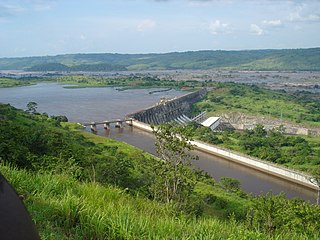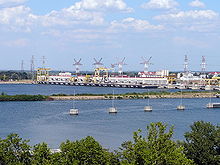
Energy in the United Kingdom came mostly from fossil fuels in 2021. Total energy consumption in the United Kingdom was 142.0 million tonnes of oil equivalent in 2019. In 2014, the UK had an energy consumption per capita of 2.78 tonnes of oil equivalent compared to a world average of 1.92 tonnes of oil equivalent. Demand for electricity in 2014 was 34.42 GW on average coming from a total electricity generation of 335.0 TWh.

Energy in Thailand refers to the production, storage, import and export, and use of energy in the Southeast Asian nation of Thailand. Thailand's energy resources are modest and being depleted. The nation imports most of its oil and significant quantities of natural gas and coal. Its energy consumption has grown at an average rate of 3.3% from 2007 to 2017. Energy from renewables has only recently begun to contribute significant energy.

Energy in Bulgaria is among the most important sectors of the national economy and encompasses energy and electricity production, consumption and transportation in Bulgaria. The national energy policy is implemented by the National Assembly and the Government of Bulgaria, conducted by the Ministry of Energy and regulated by the Energy and Water Regulatory Commission. The completely state-owned company Bulgarian Energy Holding owns subsidiaries operating in different energy sectors, including electricity: Kozloduy Nuclear Power Plant, Maritsa Iztok 2 Thermal Power Plant, NEK EAD and Elektroenergien sistemen operator (ESO); natural gas: Bulgargaz and Bulgartransgaz; coal mining: Maritsa Iztok Mines. In Bulgaria, energy prices for households are state-controlled, while commercial electricity prices are determined by the market.
The energy policy of India is to increase the locally produced energy in India and reduce energy poverty, with more focus on developing alternative sources of energy, particularly nuclear, solar and wind energy. Net energy import dependency was 40.9% in 2021-22.

Renewable energy in Portugal was the source for 25.7% of total energy consumption in 2013. In 2014, 27% of Portugal's energy needs were supplied by renewable sources. In 2016, 28% of final energy consumption in Portugal came from renewable sources.

The Energy in Russia is an area of the national economy, science, and technology of the Russian Federation, encompassing energy resources, production, transmission, transformation, accumulation, distribution, and consumption of various types of energy.

Chile's total primary energy supply (TPES) was 36.10 Mtoe in 2014. Energy in Chile is dominated by fossil fuels, with coal, oil and gas accounting for 73.4% of the total primary energy. Biofuels and waste account for another 20.5% of primary energy supply, with the rest sourced from hydro and other renewables.

Energy in Romania describes energy and electricity production, consumption and import in Romania.

Vietnam is a dynamic developing economy with a relatively high growth rate. The energy sector plays a key role in promoting the country's socio-economic development. Vietnam has a diverse energy fuel resource of various types such as coal, natural gas, petroleum, hydropower and renewables such as solar and wind energy. The country has recently been successful in renewable energy deployment, especially solar and wind power development. Coal has been the key power generation source since 2018. Coal accounted for about 30% of installed capacity and 47% of electricity generation in 2021 The high use of coal makes Vietnam an increasingly important emitter of carbon dioxide, contributing to climate change.
According to the International Hydropower Association, Canada is the fourth largest producer of hydroelectricity in the world in 2021 after the United States, Brazil, and China. In 2019, Canada produced 632.2 TWh of electricity with 60% of energy coming from Hydroelectric and Tidal Energy Sources).
Elektroprivreda Srbije is a joint-stock electric utility power company fully owned by the Government of Serbia, with headquarters in Belgrade, Serbia. It was founded in 1991 and it has 24,013 employees, making it the largest enterprise in the country.
Romania is the 38th largest energy consumer in the world and the largest in South Eastern Europe as well as an important producer of natural gas, oil and coal in Europe.

The Democratic Republic of the Congo was a net energy exporter in 2008. Most energy was consumed domestically in 2008. According to the IEA statistics the energy export was in 2008 small and less than from the Republic of Congo. 2010 population figures were 3.8 million for the RC compared to CDR 67.8 Million.

Energy in Italy comes mostly from fossil fuels. Among the most used resources are petroleum, natural gas, coal and renewables. Italy has few energy resources, and most supplies are imported.

The utility electricity sector in Bangladesh has one national grid with an installed capacity of 25,700 MW as of June 2022. Bangladesh's energy sector is not up to the mark. However, per capita energy consumption in Bangladesh is considered higher than the production. Electricity was introduced to the country on 7 December 1901
Renewable energy in Russia mainly consists of hydroelectric energy. Russia is rich not only in oil, gas and coal, but also in wind, hydro, geothermal, biomass and solar energy – the resources of renewable energy. Practically all regions have at least one or two forms of renewable energy that are commercially exploitable, while some regions are rich in all forms of renewable energy resources. However, fossil fuels dominate Russia’s current energy mix, while its abundant and diverse renewable energy resources play little role.

In 2019, the total energy production in Indonesia is 450.79 Mtoe, with a total primary energy supply is 231.14 Mtoe and electricity final consumption is 263.32 TWh. Energy use in Indonesia has been long dominated by fossil resources. Once a major oil exporter in the world and joined OPEC in 1962, the country has since become a net oil importer despite still joined OPEC until 2016, making it the only net oil importer member in the organization. Indonesia is also the fourth-largest biggest coal producer and one of the biggest coal exporter in the world, with 24,910 million tons of proven coal reserves as of 2016, making it the 11th country with the most coal reserves in the world. In addition, Indonesia has abundant renewable energy potential, reaching almost 417,8 gigawatt (GW) which consisted of solar, wind, hydro, geothermal energy, ocean current, and bioenergy, although only 2,5% have been utilized. Furthermore, Indonesia along with Malaysia, have two-thirds of ASEAN's gas reserves with total annual gas production of more than 200 billion cubic meters in 2016.

Primary energy consumption in Spain in 2020 was mainly composed of renewable sources. The largest sources are petroleum (42.3%), natural gas (19.8%) and coal (11.6%). The remaining 26.3% is accounted for by nuclear energy (12%) and different renewable energy sources (14.3%). Domestic production of primary energy includes nuclear (44,8%), solar, wind and geothermal (22,4%), biomass and waste (21,1%), hydropower (7,2%) and fossil (4,5%).
TPP Kostolac is a coal fired thermal power plant complex operated by Elektroprivreda Srbije, located on the right bank of Danube river, in Kostolac, Požarevac. It is the second largest power plant in Serbia after TPP Nikola Tesla. Within the complex, there are 4 operational units as of October 2020. It makes around 10% of the total available capacity of the electric power system of Serbia and almost 11 percent of the total electric power production in EPS's system.

By the end of 2016 Austria already fulfilled their EU Renewables Directive goal for the year 2020. By 2016 renewable energies accounted to 33.5% of the final energy consumption in all sectors. The renewable energy sector is also accountable for hosting 41,591 jobs and creating a revenue of 7,219 million euros in 2016.


















